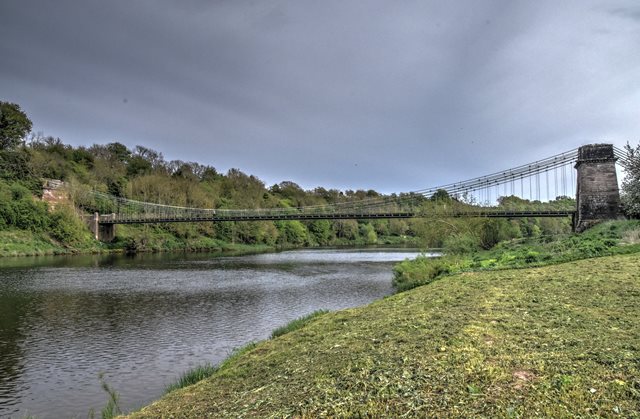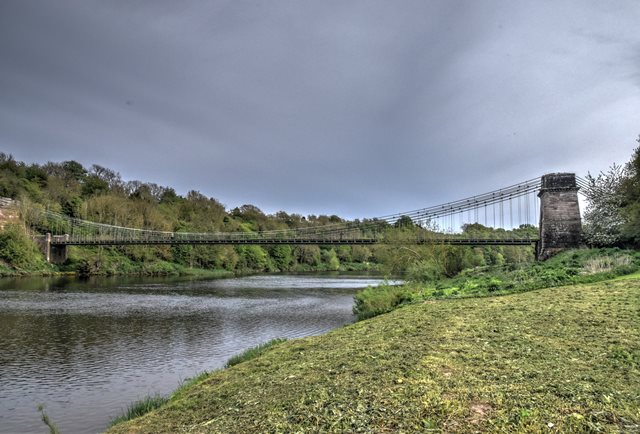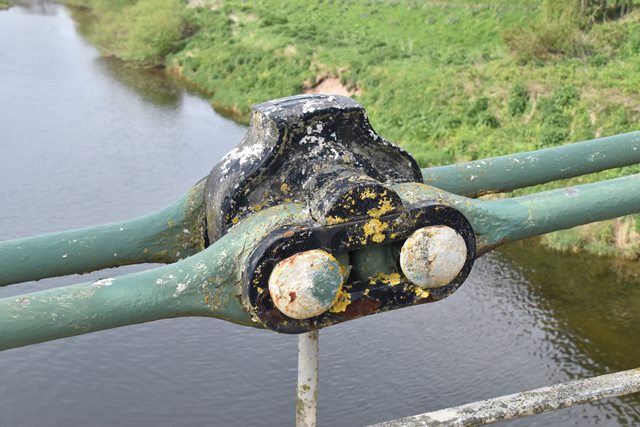We Recommend:
Bach Steel - Experts at historic truss bridge restoration.
BridgeHunter.com Phase 1 is released to the public! - Visit Now
Union Chain Bridge
Union Suspension Bridge

Primary Photographer(s): Nathan Holth
Bridge Documented: May 13, 2018
Berwick-upon-Tweed and Fishwick: North East, England and Scottish Borders, Scotland: United Kingdom
Not Available or Not Applicable
360.0 Feet (109.7 Meters)
449.0 Feet (136.9 Meters)
Not Available
1 Main Span(s)
Not Applicable

View Information About HSR Ratings
Bridge Documentation
View Friends of the Union Chain Bridge Website
View Article By Friends of Union Chain Bridge In Historic Bridge Foundation Newsletter
View Friends of Union Chain Bridge Newsletter Describing History of Decorative Crests
View Historical Book About Suspension Bridges Which Discusses This Bridge
This bridge, when built in 1819-1820, was the first vehicular suspension bridge in Europe. It also had a record-breaking span when built. The bridge has a very unique layout, with the east end of the bridge having no tower whatsoever, and instead featuring a unique anchorage built into the natural rocky cliff at this side of the river. At this end, the eyebar chains do not pass over a tower and descend to ground level, and instead continue rising, passing over the approaching roadway, (which makes a sharp bend) and enter into the anchorage above the road. At the west end, a more traditional layout is found, with a stone tower holding the cables aloft at the end of the span, and leading away from the bridge, back-stay chains leading down to anchorages located at ground level.
Despite its age, the bridge retains good integrity in terms of the original design. The bridge retains its classic eyebar chains. The bridge has been supplemented with a wire cable, added above the original eyebar chain. The Friends of the Union Chain Bridge has proposed removing this alteration as part of restoration efforts, which would return the bridge to its original design and appearance.
Decorative crests on the towers, which were originally mounted at the center of the bridge on the chains, read "Vis Unita Fortior" which translates to "United Strength is Stronger."
Please refer to the article above, and official heritage information below for more detailed histories of this bridge. The Friends of the Union Chain Bridge are currently engaged in an ongoing effort to preserve and restore this bridge. Visit their website to learn more.

Above: Captain Samuel Brown, Designer/Builder of Bridge
Official Heritage Listing Information and FindingsEngland: Listed At: Grade I Scotland: Listed At: Category A Scotland (Bridge House): Listed At: Category C Discussion: England: List Entry Number: 1042214 Discussion: Scotland: Historic Environment Scotland Number: LB13645 Discussion: Scotland (Bridge House): Historic Environment Scotland Number: LB47714 |
![]()
Photo Galleries and Videos: Union Chain Bridge
Structure Overview
Original / Full Size PhotosA collection of overview photos that show the bridge as a whole and general areas of the bridge. This gallery offers photos in the highest available resolution and file size in a touch-friendly popup viewer.
Alternatively, Browse Without Using Viewer
![]()
Structure Details
Original / Full Size PhotosA collection of detail photos that document the parts, construction, and condition of the bridge. This gallery offers photos in the highest available resolution and file size in a touch-friendly popup viewer.
Alternatively, Browse Without Using Viewer
![]()
Structure Overview
Mobile Optimized PhotosA collection of overview photos that show the bridge as a whole and general areas of the bridge. This gallery features data-friendly, fast-loading photos in a touch-friendly popup viewer.
Alternatively, Browse Without Using Viewer
![]()
Structure Details
Mobile Optimized PhotosA collection of detail photos that document the parts, construction, and condition of the bridge. This gallery features data-friendly, fast-loading photos in a touch-friendly popup viewer.
Alternatively, Browse Without Using Viewer
![]()
Maps and Links: Union Chain Bridge
Coordinates (Latitude, Longitude):
Search For Additional Bridge Listings:
Additional Maps:
Google Streetview (If Available)
GeoHack (Additional Links and Coordinates)
Apple Maps (Via DuckDuckGo Search)
Apple Maps (Apple devices only)
Android: Open Location In Your Map or GPS App
Flickr Gallery (Find Nearby Photos)
Wikimedia Commons (Find Nearby Photos)
Directions Via Sygic For Android
Directions Via Sygic For iOS and Android Dolphin Browser
Ordnance Survey Maps (UK Only)



